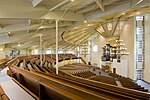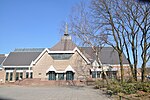Barneveld Noord railway station
1938 establishments in the NetherlandsRailway stations closed in 1944Railway stations in BarneveldRailway stations in the Netherlands opened in the 1930sRailway stations in the Netherlands opened in the 1950s ... and 3 more
Railway stations on the ValleilijnRailway stations opened in 1938Railway stations opened in 1951

Barneveld Noord is a railway station located in Harselaar and the north of Barneveld, Netherlands. The distance to the railway station from the center of the city Barneveld Centrum is 2.8 kilometers. The station was opened on 15 May 1938 and is located on the Valleilijn. The station closed on 7 September 1944 and re-opened 20 May 1951. Valleilijn trains operated by Connexxion call at this station and were previously operated by Nederlandse Spoorwegen. The station has one platform and since 2006 a park and ride facility called Transferium Barneveld-Noord off the A1 motorway Junction 16.
Excerpt from the Wikipedia article Barneveld Noord railway station (License: CC BY-SA 3.0, Authors, Images).Barneveld Noord railway station
Barneveld Noord, Barneveld
Geographical coordinates (GPS) Address Nearby Places Show on map
Geographical coordinates (GPS)
| Latitude | Longitude |
|---|---|
| N 52.161111111111 ° | E 5.5983333333333 ° |
Address
Barneveld Noord
Barneveld Noord
3771 PR Barneveld
Gelderland, Netherlands
Open on Google Maps










